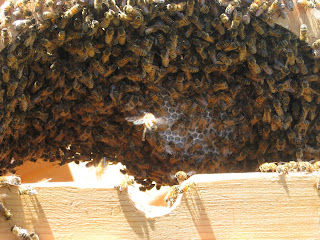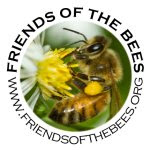Ok we've been working on this tree for a year now.
http://deweysbees.blogspot.com/2012/05/huge-bee-tree.html

History: At first we tried to trap out the bees.
story here
We came back in a week and the bees had chewed a hole through the spray foam to create another entrance to the main colony (see below pic).
We decided trapping them out was not going to work and we'd need to cut them out.
We removed the dead bit in front to reveal the colony. It was about eye level inside the cavity and went up above where we could see (though we couldn't tell how far).
View from in front of entrance
We removed as much comb as we could. Much of it brood comb. We cut the comb and tied it into frames.
View from inside tree - under colony
Note the curve of the comb (about 2 foot across)
brood comb tied in
after partial comb removal
colony with partial comb removed.
This process took quite a bit of time and we had a late start so it got dark on us. We decided to finish tomorrow. We left the brood comb in a box as the base of the tree. We never did see the queen.
The next day we found that the nurse bees that had been in the box had abandoned it and moved back into the tree. Any honey that was tied in the brood comb boxes was robbed out and the brood there abandoned.
We left it alone to come back another day.
We ended up never getting back to it last summer so I went back in November to make sure they were protected from the winter wind by nailing boards up over the huge entrance. They had rebuilt entirely and surprisingly this time the comb was perfectly straight instead of curved as before.
Note the straight comb.
Yesterday we decided to give it another go.
We removed the boards. The colony was huge. The comb covered with bees until we smoked it.
From the entrance
From beneath (note the queen cell)
This time we used a bee vac to remove the girls from the comb before we cut it out. This worked pretty good. They were still surprisingly gentle girls. The comb extends above the entrance about a foot. We tried to use a long skinny piece of wood fixed with a screw to cut it off at the top. The idea was that the skinny wood would fit up between the combs (and it did). It could then be rotated 90 degrees to twist the screw into the comb and then used as a knife to cut the comb at the top. It sounded great in theory but in the end it didn't work. It squished a lot of bees going up between the combs and didn't do a good job of comb cutting. We ended up getting a hold of the comb as best we could and pulling it down while rocking it side to side. This broke it off up above somewhere and we were able to pull it down and remove it. Most of the comb had to be cut in half in order to rotate it to fit it out the entrance.
We vacuumed each comb off as we removed it and stacked all comb on a working table. Paul is pretty sure he saw the queen just as she went into the vacuum tube.
We ended up finding many queen cells - some hatched. I'm pretty sure this colony had already swarmed for several reasons. 1 - the presence of hatched queen cells. Usually the mother queen tries to be gone before any of the daughter queens hatch. 2 - the completely back filled brood area. There was not an open brood cell anywhere in the hive. Plenty of capped brood but none open. The first queen cell we found was in an unusual place. right in the middle of a comb of pollen. The location suggests supercedure cell. But there were many many queen cells on the bottom of comb also suggesting swarm cells. Hmmmm?
Pollen
Queen cell in pollen - supercedure?
Queen cells on comb bottom - swarm?
Queen cell cluster from below
Many hatched - many still capped.
The first queen cell we removed was from the pollen. It had not hatched so we set it aside to deal with later. The second queen cell we removed was from the bottom/side of the comb and hatched out in Paul's hand as we removed it. We caught here and put her into a queen cage. We checked the first cell and found it had hatched also (in the 2 minutes it was sitting there) and she was crawling around on the empty cell. We caged her also. We removed quite a few more capped queen cells that we've placed in nucs to try to keep alive. We'll use any that hatch for splits.
WE removed all the comb we could reach, vacuumed as many bees from the tree as we could and called it a night.
We ended up with about 5-6 lbs of bees that we split into 2 boxes. Each box with a hatched virgin queen in a cage and brood and pollen/honey.
As much comb removed as we could reach
left - comb removed last year
right - comb removed this year and not tied in





















































